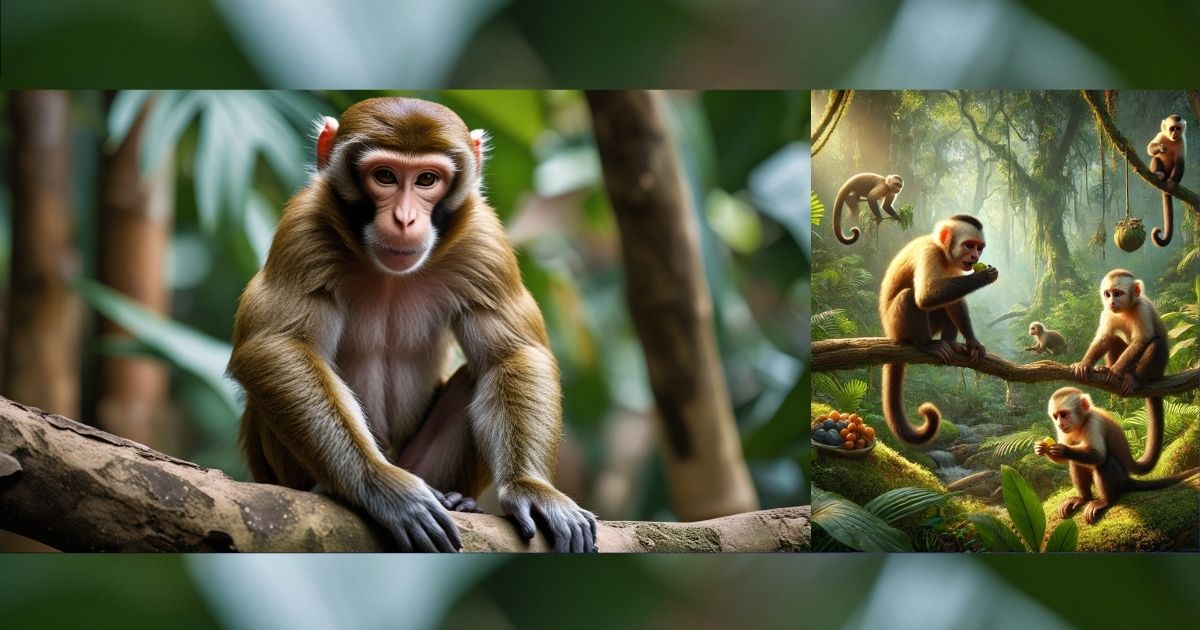Capuchin monkeys (Cebus capucinus) are one of the most fascinating and intelligent primates found in the Americas.
Native to regions of Central America and South America, these monkeys are highly adaptable and have evolved to thrive in diverse environments, ranging from tropical evergreen forests to dry deciduous forests.
Known for their dexterity and social nature, Capuchins play a vital role in maintaining the health of forests and promoting biodiversity.
In this comprehensive guide, we will delve into the life and behavior of the Capuchin monkey, covering everything from their habitat and diet to their importance in the ecosystem, lifespan, and conservation efforts.
Quick Facts about the Capuchin Monkey
Before diving deeper into the life of the Capuchin monkey, here are some quick facts that provide a snapshot of their characteristics:
| Attribute | Details |
| Scientific Name | Cebus capucinus |
| Common Name | Capuchin Monkey |
| Class | Mammal |
| Weight | 3 to 9 pounds |
| Diet | Omnivore (Fruits, nuts, small vertebrates) |
| Lifespan in the Wild | 15 to 25 years |
| Lifespan in Captivity | 35 to 45 years (with proper care) |
| Conservation Status | Vulnerable |
| Group Size | 18 to 20 individuals (social animals) |
Capuchin monkeys are highly adaptable, playing a crucial role in the biodiversity of their ecosystems. They live in groups of 18 to 20 individuals, exhibiting complex social behaviors.
Read More: Monkey Names: Funny, Cute, and Unique Ideas
Video: Capuchin Monkeys in the Wild
Watch a video of Capuchin monkeys in their natural habitat, where you can see them interacting with each other, foraging for food, and demonstrating their intelligence and tool use.
These primates are incredibly agile, utilizing their prehensile tails for balance and movement in the treetops.
About Capuchin Monkeys
Capuchin monkeys are a species of mammals in the primate family, famous for their intelligence and social structure.
They are found primarily in Central America and parts of South America, where they inhabit tropical evergreen forests and dry deciduous forests.
The Capuchin monkey is one of the most intelligent species in the primate world, capable of using tools and solving complex problems.
I LIVE IN CENTRAL AND SOUTH AMERICA
Capuchin monkeys are distributed across Central America (including Honduras, Costa Rica, and Panama) and Northwestern South America (including Colombia, Ecuador, and Venezuela). These regions offer the tropical evergreen forests and dry deciduous forests that Capuchins prefer.
Their ability to adapt to varying environments, from the humid jungles to dry, arid areas, is one of the reasons why they have remained successful in their habitats.
Capuchins rely on their environment for shelter, food, and protection. Their social groups live in the trees, which are crucial for safety from predators and access to food sources.
I AM AN OMNIVORE
Capuchin monkeys are omnivores, which means they eat both plant and animal matter. The bulk of their diet consists of fruits and nuts, which are abundant in their tropical habitats.
However, Capuchins are also opportunistic feeders, meaning they will consume whatever food is available, including small vertebrates like squirrels, lizards, and birds. This ability to adjust their diet based on availability is vital for their survival in the wild.
In the wild, Capuchins are skilled foragers, using their dexterous hands and prehensile tails to collect food from various trees.
Their tool-use behaviors are particularly notable, as they have been observed using sticks to extract insects or break open hard fruits.
Capuchin Monkeys Are Social Animals
Capuchin monkeys are known for their social structure and strong group dynamics. These monkeys live in groups of 18 to 20 individuals, with clear hierarchies and roles within the group.
The group living lifestyle provides benefits such as protection from predators, finding food more effectively, and forming social bonds that aid in survival.
Female Capuchins
Female Capuchins are more likely to stay within the group they were born into, a behavior known as philopatry.
This bond ensures that female Capuchins have strong connections within the group, which can be crucial for raising offspring.
These females are often the primary caregivers, with parental care being a key aspect of their social structure.
Male Capuchins
Male Capuchins, on the other hand, leave the group they were born into at around four years of age. They typically seek out new groups to join as adults.
This migration behavior helps maintain genetic diversity and ensures that the gene pool remains strong.
Hitching a Ride: Baby Capuchins
The bond between mother and baby Capuchins is strong. Baby Capuchins ride on their mothers’ backs for the first six months of their lives.
This period is crucial for the infant’s survival, as they are protected from predators and able to stay close to their mothers for feeding and comfort.
Mother Capuchins are responsible for providing parental care—feeding, grooming, and protecting their young.
Unlike many other primates, male Capuchins have little involvement in raising their young, and their role is mainly centered around the group’s social structure.
Helping Capuchin Monkeys in the Wild
Capuchin monkeys face numerous challenges in the wild, including habitat loss, illegal pet trade, and hunting.
As a result, their populations are in decline, and the Capuchin monkey is currently listed as vulnerable by the International Union for Conservation of Nature (IUCN).
The Species Survival Plan (SSP)
To address the decline in Capuchin populations, organizations like the Association of Zoos and Aquariums (AZA) have implemented the Species Survival Plan (SSP).
This program aims to protect genetic viability by breeding Capuchins in captivity and eventually reintroducing them into their natural habitats.
Zoos and aquariums play an important role in Capuchin monkey conservation by providing safe, controlled environments where researchers can study their behaviors, health, and reproduction.
The goal is to ensure that Capuchin monkeys continue to thrive both in the wild and in captivity.
Capuchin Monkey Habitat
The habitat of Capuchin monkeys varies from tropical evergreen forests to dry deciduous forests, but one thing remains constant: they require trees for shelter, food, and safety.
Capuchins are arboreal creatures, meaning they spend most of their time in the treetops, moving through the forest using their prehensile tails to maintain balance.
These monkeys prefer dense forests that offer plenty of food resources, including fruits, nuts, and seeds.
However, Capuchins are also capable of surviving in coastal regions or areas with less rainfall, as long as there are sufficient trees and food sources.
Capuchin Monkey Diet
Capuchins are omnivores, consuming a wide range of foods that include fruits, nuts, seeds, and flowers. They also eat small animals such as squirrels, lizards, and birds when the opportunity arises.
This opportunistic feeding allows them to thrive in varying habitats, where food sources can be unpredictable.
Capuchins are also known for their tool use, employing sticks and stones to extract food from difficult-to-reach places.
For example, they have been observed using rocks to crack open nuts or sticks to retrieve insects from tree bark.
Capuchin Monkey Family
Capuchins live in groups with a well-defined social structure. A typical group consists of 18 to 20 individuals, and the social dynamics within the group are essential for the survival of the monkeys.
Female Capuchins are often the leaders, providing the group with stability and ensuring that young monkeys are nurtured and protected.
How Many Capuchin Monkeys Are Left in the World?
The Capuchin monkey is currently listed as vulnerable, meaning that their populations are at risk due to factors like deforestation, illegal hunting, and the pet trade. Estimates suggest that Capuchin populations are in decline, with fewer individuals remaining in the wild.
However, thanks to conservation efforts like the Species Survival Plan (SSP), there is hope for their recovery.
By supporting conservation programs and protecting their natural habitats, we can ensure that Capuchin monkeys continue to play their important role in maintaining the health of forests and promoting biodiversity.
Conclusion
The Capuchin monkey is a remarkable species known for its intelligence, social behavior, and vital role in maintaining the balance of ecosystems.
These monkeys have adapted to a variety of habitats in Central and South America, and they are essential to forest health through their actions as seed dispersers.
However, habitat loss and illegal activities have placed them at risk, making conservation efforts essential to their survival.
With the help of organizations like the Association of Zoos and Aquariums (AZA) and programs like the Species Survival Plan (SSP), there is hope for the future of Capuchin monkeys.
By continuing to protect their habitats and support conservation efforts, we can ensure that these social animals thrive for generations to come.

Streamnexs.com offers a creative collection of Animal and Bird Name Ideas, helping pet owners, enthusiasts, and Bird Lovers Find Unique, Meaningful, and Fitting Names for their Feathered and Furry Friends.
